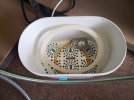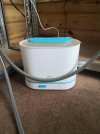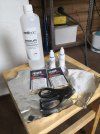Kloakk
Norbrygg-medlem
Jeg kom over en artikkel på r/homebrewing her om dagen som tar opp og forklarer hvorfor tåkete Starsan ikke er til å stole på. Jeg har sett at her på forumet har det vært oppe et par ganger, hvor konsesus har vært at så lenge pH er lav vil den gjøre jobben sin.
La det være krystalklart at det stemmer rett å slett ikke og tåkete starsan bør ikke benyttes til desinfisering. Jeg har ikke tenkt å verken prøve eller bruke tid på å forklare det på moderspråket vårt, men jeg legger ved artikkelen også kan de som har en interesse om emne lese den selv
Star San Facts
Author: /u/chino_brews
The Star San Myth
There is a myth that Star San works fine even if it has turned cloudy, if the pH remains at or below 3.5 pH. This is a myth.
Where does the myth come from?
The incomplete information was unfortunately spoken by Charlie Talley, the inventor of Star San at Five Star Chemicals, in one or more podcast episodes. However, Charlie Talley walked back that comment later in the same podcast episode (or another episode) and stated that if the prepared solution turns cloudy, the brewer should not store the solution and should mix a new batch when needed. The product reps at Five Star have been repeating the myth that pH alone is all you need to check, but when the author pressed them at a brewing conference (armed with knowledge), the reps confirmed the author that minerals or soils in the water will reduce the effectiveness of the sanitizer.
The Problem: Yeast are OK with Acid
It's important to understand that yeast are adapted to surviving in very low pH environments. They are able to keep that environment outside of their cells. You can acid wash yeast at 2.5 pH, which is a normal laboratory procedure to eliminate some microbes and clean up a culture In fact, the author has done so -- with phosphoric acid, the same acid in Star San -- and ended up with a healthy culture. Therefore, the fact that prepared Star San has a pH of 3.5 alone is not sufficient to establish its continued killing power.
How Star San Works
Star San is an acid-anionic detergent. It's not unique. It is not the first or only acid-anionic detergent on the market. Many household products you use include anionic and nonionic surfactants, including some laundry detergents.
Star San has three active ingredients: phosphoric acid and DDBSA (detergent/surfactant), plus propylene glycol for viscosity control. The acid and detergent/surfactant form a one-two punch and need to work together. The acidity is necessary to support the action of the detergent. The detergent molecule has a hydrophilic (water-attracting) end and a hydrophobic (water repelling end) end. The detergent dissasociates (takes apart) the cell walls and membranes of the cell when one end of a detergent molcule bonds with a microbes' cell wall or membrane molecule and the othen end bonds with a water molecule, and one building block of the cell's defense is taken away. When the cell wall or membrane is degraded enough, acid and detergent leak into the cell, killing the cell.
Why Cloudiness Negatively Impacts the Efficacy of Star San
If Star San is getting cloudy, then the detergent molecule is binding to minerals or soils in the water and is not available to take apart the microbe's defensive wall. It is attacking the soils rather than the microbes. Thus, the cloudy Star San solution becomes less effective.
A Better Way to Use Star San
None other than Charlie Talley raves about using distilled ("deionized") water to mix up prepared Star San solution.
Make your prepared Star San solution using one gallon of distilled water. As of this writing (August 2021), one gallon of distileld water costs about one dollar in the USA. Obtain a 10 ml oral medicine dosing syringe. Your local pharmacy will be happy to give you one or sell it to you for less than a dollar. Inject 6 ml of Star San product into the jug pf distilled water. Shake/tumble it in your hands to mix the components. The author likes to allow it to sit for a while.
Load the prepared Star San sanitizer into high quality spray bottle(s). The HDX brand from Home Depot work very well for this application and for general brewing use, as do the Zep brand. Spray down and exterior surface that needs sanitizing until it is thoroughly wetted, and slow count to 30 seconds. For interior surfaces like inside of carboys or tubing, spray or pour just enough prepared Star San sanitizer into it so that you can slosh it around and wet every surface, then wait the same 30 seconds.
Cost
One jug of prepared Star San sanitizer used this way can easily last more than five brews, from brew day through kegging or bottling if you use a Vinator to sanitize bottles. As of August 2021, one 8 oz container of Star San is $9.29 at Ritebrew, an HDX sprayer is $2.28, distilled water is $0.89 at Walmart, and a dosing syringe is two for $1 at the pharmacy counter (rather than the retail shelf) at CVS. The bottle will yield 38 doses of 6 ml.
If you add up the cost of everything, the cost of prepared Star San sanitizer is $1.33 per one gallon of sanitizer, And no more than $0.27 per batch of beer (over five batches of beer from start to finish); however, you may need to sanitize beer bottles using a sulfiter or the spray bottle to mimimize wastage.
Direct quote from Charlie Talley:
[Star San has three active ingredients: phosphoric acid, DDBSA, and propylene glycol] The acid-ionic [detergent or surfactant] is a synergistic killing machine. The acid by itself will not kill bacteria. The anionic detergent by itself will not kill bacteria. The combination of the two, at the correct ratio, is an absolute stone killer ... [The EPA requires you to make a fresh batch of sanitizer for every use ...] The material is kind of interesting. Like I mentioned before it is a, uh, it is a soap. It’s an acid anionic detergent. Um, if it’s made with deionized water, if the used solution is made with deionized water and there are no minerals in the water itself, um, the used solution is active for literally months. Uh, if there’s minerals in the water, what will happen over a period of time, the minerals will win out over time and they’ll start to create a hard water soap. The hard water soap will make the product cloudy. Only because, just like people use bar soap and they get soap tub rings. It works identically. There’s no difference in the chemical reactions behind it. And any brewer that uses the product and is in a hard water situation, I always tell ‘em to go to the supermarket and buy a jug of deionized water off the shelf. Um, they’ll thank me for it later on — and they do. They call me back up and they say, “Boy the water, you know, the sanitizing solution is crystal clear. Some of ‘em even have pH meters, um, some home brewers. And, uh, they go, “My pH it, uh, remains at 3, um, for two or three months.” I say, “Yeah, you’re still sanitizing. You’re still killing ... You can test the effectiveness in two ways, by the pH, or by the, uh, turbidity of the actual used solution. How cloudy it is.”
(The language is brackets belongs to the author.)
La det være krystalklart at det stemmer rett å slett ikke og tåkete starsan bør ikke benyttes til desinfisering. Jeg har ikke tenkt å verken prøve eller bruke tid på å forklare det på moderspråket vårt, men jeg legger ved artikkelen også kan de som har en interesse om emne lese den selv
Star San Facts
Author: /u/chino_brews
The Star San Myth
There is a myth that Star San works fine even if it has turned cloudy, if the pH remains at or below 3.5 pH. This is a myth.
Where does the myth come from?
The incomplete information was unfortunately spoken by Charlie Talley, the inventor of Star San at Five Star Chemicals, in one or more podcast episodes. However, Charlie Talley walked back that comment later in the same podcast episode (or another episode) and stated that if the prepared solution turns cloudy, the brewer should not store the solution and should mix a new batch when needed. The product reps at Five Star have been repeating the myth that pH alone is all you need to check, but when the author pressed them at a brewing conference (armed with knowledge), the reps confirmed the author that minerals or soils in the water will reduce the effectiveness of the sanitizer.
The Problem: Yeast are OK with Acid
It's important to understand that yeast are adapted to surviving in very low pH environments. They are able to keep that environment outside of their cells. You can acid wash yeast at 2.5 pH, which is a normal laboratory procedure to eliminate some microbes and clean up a culture In fact, the author has done so -- with phosphoric acid, the same acid in Star San -- and ended up with a healthy culture. Therefore, the fact that prepared Star San has a pH of 3.5 alone is not sufficient to establish its continued killing power.
How Star San Works
Star San is an acid-anionic detergent. It's not unique. It is not the first or only acid-anionic detergent on the market. Many household products you use include anionic and nonionic surfactants, including some laundry detergents.
Star San has three active ingredients: phosphoric acid and DDBSA (detergent/surfactant), plus propylene glycol for viscosity control. The acid and detergent/surfactant form a one-two punch and need to work together. The acidity is necessary to support the action of the detergent. The detergent molecule has a hydrophilic (water-attracting) end and a hydrophobic (water repelling end) end. The detergent dissasociates (takes apart) the cell walls and membranes of the cell when one end of a detergent molcule bonds with a microbes' cell wall or membrane molecule and the othen end bonds with a water molecule, and one building block of the cell's defense is taken away. When the cell wall or membrane is degraded enough, acid and detergent leak into the cell, killing the cell.
Why Cloudiness Negatively Impacts the Efficacy of Star San
If Star San is getting cloudy, then the detergent molecule is binding to minerals or soils in the water and is not available to take apart the microbe's defensive wall. It is attacking the soils rather than the microbes. Thus, the cloudy Star San solution becomes less effective.
A Better Way to Use Star San
None other than Charlie Talley raves about using distilled ("deionized") water to mix up prepared Star San solution.
Make your prepared Star San solution using one gallon of distilled water. As of this writing (August 2021), one gallon of distileld water costs about one dollar in the USA. Obtain a 10 ml oral medicine dosing syringe. Your local pharmacy will be happy to give you one or sell it to you for less than a dollar. Inject 6 ml of Star San product into the jug pf distilled water. Shake/tumble it in your hands to mix the components. The author likes to allow it to sit for a while.
Load the prepared Star San sanitizer into high quality spray bottle(s). The HDX brand from Home Depot work very well for this application and for general brewing use, as do the Zep brand. Spray down and exterior surface that needs sanitizing until it is thoroughly wetted, and slow count to 30 seconds. For interior surfaces like inside of carboys or tubing, spray or pour just enough prepared Star San sanitizer into it so that you can slosh it around and wet every surface, then wait the same 30 seconds.
Cost
One jug of prepared Star San sanitizer used this way can easily last more than five brews, from brew day through kegging or bottling if you use a Vinator to sanitize bottles. As of August 2021, one 8 oz container of Star San is $9.29 at Ritebrew, an HDX sprayer is $2.28, distilled water is $0.89 at Walmart, and a dosing syringe is two for $1 at the pharmacy counter (rather than the retail shelf) at CVS. The bottle will yield 38 doses of 6 ml.
If you add up the cost of everything, the cost of prepared Star San sanitizer is $1.33 per one gallon of sanitizer, And no more than $0.27 per batch of beer (over five batches of beer from start to finish); however, you may need to sanitize beer bottles using a sulfiter or the spray bottle to mimimize wastage.
Direct quote from Charlie Talley:
[Star San has three active ingredients: phosphoric acid, DDBSA, and propylene glycol] The acid-ionic [detergent or surfactant] is a synergistic killing machine. The acid by itself will not kill bacteria. The anionic detergent by itself will not kill bacteria. The combination of the two, at the correct ratio, is an absolute stone killer ... [The EPA requires you to make a fresh batch of sanitizer for every use ...] The material is kind of interesting. Like I mentioned before it is a, uh, it is a soap. It’s an acid anionic detergent. Um, if it’s made with deionized water, if the used solution is made with deionized water and there are no minerals in the water itself, um, the used solution is active for literally months. Uh, if there’s minerals in the water, what will happen over a period of time, the minerals will win out over time and they’ll start to create a hard water soap. The hard water soap will make the product cloudy. Only because, just like people use bar soap and they get soap tub rings. It works identically. There’s no difference in the chemical reactions behind it. And any brewer that uses the product and is in a hard water situation, I always tell ‘em to go to the supermarket and buy a jug of deionized water off the shelf. Um, they’ll thank me for it later on — and they do. They call me back up and they say, “Boy the water, you know, the sanitizing solution is crystal clear. Some of ‘em even have pH meters, um, some home brewers. And, uh, they go, “My pH it, uh, remains at 3, um, for two or three months.” I say, “Yeah, you’re still sanitizing. You’re still killing ... You can test the effectiveness in two ways, by the pH, or by the, uh, turbidity of the actual used solution. How cloudy it is.”
(The language is brackets belongs to the author.)




